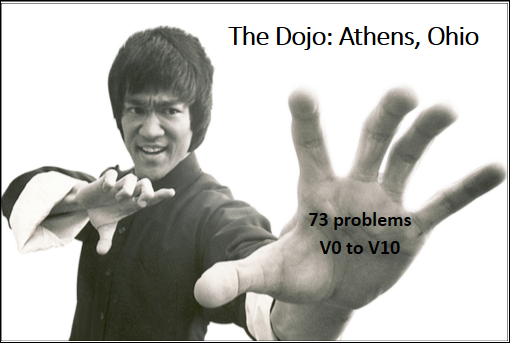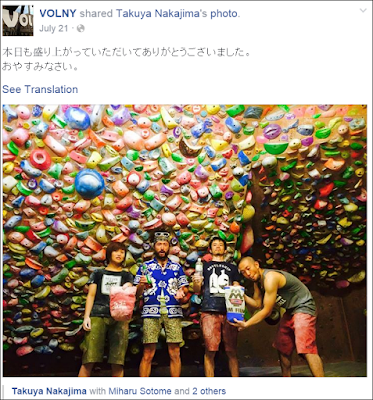(This is the cover of the Dojo guidebook)
Like Bruce Lee, our Dojo packs a lot of quality into a small frame. The wall is only 7.5 feet tall (at the center), but it fills a wide room that allows traverses and roof crossing. In that space we have over 70 problems, ranging in length from 3 moves to 80, and difficulty from V0 to V10.
What can you do with your holds and problem setting to get more value from your home climbing wall? Here are some ideas that we have been using at the Dojo:
- Increase diversity of hold selection
- Develop a wide repertoire of problem types
- Document the routes with a guidebook
- Record community accomplishments in the guidebook
Diverse holds:
Elsewhere I describe holds that I especially like, but my most important rule is that I want basic holds for cheap so I can spend money on compelling holds that expand the diversity and allow movement types that would otherwise be impossible.
The very big: holds like the Teagan Kaiju stalactites are ideal for this, and the "Kids Kaiju" problem feels super 3 dimensional, and even has a roof kneebar that my daughters discovered. Along with the three Kaiju we have 4 more giant holds from Etch and Urban Plastix. These rare but valuable holds are in contrast to the smallest, most numerous, and most technically valuable holds.
The very small: On the far side of the spectrum are 100's of tiny jibs that increase the realism and training value of all of the problems. Some of the best of these are the sandstone chips from eGrips, multifaceted, small and technical. I also have dozens of simple homemade jibs made from bean sized sections of oak molding.
The very compact: most home walls have limited space, so the best hand holds will offer distinct types of grips with small footprints. Wide bottomed slopers are not ideal because they consume so much real estate. In the space of one sloper you might fit in 4 or 5 more compact holds, that could allow for simple edges, gaston moves, underclings, pinches, etc. The photo on the right includes UP ribbon pinches, Atomik system holds, comfy crimps & bubble wrap ledges from eGrips, screw on edges from Synrock, and green Kilter Winters and purple Teagans which offer great directional edges with small footprints.
Punchline: the ideal home wall will maximize both the diversity and density of holds. This allows the most variety of problems to cross the same space. So, don't be afraid to add extra t-nuts, or screw the holds in with deck screws in the spaces between your other holds. While you are at it throw in some more jibs, which you can buy in color coded sets to make problems that just use a certain color of footholds.
Set a wide variety of problem types
If (A) you have many diverse holds and (B) you have a lot of good problems then (C) you do not need to move your holds often. This saves work and builds continuity. So, fill your wall before you move your holds. If you have densely packed diverse holds you will have no shortage of good movement options through every square foot of your wall. We use different rules for different problems to get more options for building skill and training.
(The standard problem "Mercy, the Pabst" starts and finishes on the PVC pipe above the clock; the foothold only constraint problem "Blues Clues" starts and finishes on the blue taped footchip on the right, and includes all similar blue, tic marked footchips; the tracking problem "Black Flag" starts on the left side of the low angled roof and finishes on the roof rail in the foreground; the sequenced problem "Tuna Town Trainer" has hold number 34 in the foregrounded roof crimp.)
Standard taped problems: Standard problems have taped handholds and allow any foothold. Most are 5 to 15 moves long. However, "Mercy the Pabst" is a 60 foot room traverse with about 50 hand moves. This 5.11a mimics the Red River namesake with boulder problems punctuated with good rests. With technical and fitness cruxes this route provides a tangible goal for many climbers that helps usher in the resting and route planning skills necessary to climb solid 5.10 outdoors. For others, the same route is just part of their 20 minute ARC sessions, or a handy litmus test for recognizing low gravity days.
Tracking: Tracking problems restrict both hands and feet to taped holds. These allow a higher level of control over movement and generally lead to more extreme positions than the "any feet" rule of standard problems. This rule is typical for mid length problems that integrate distinctive moves like heel hooks, bicycles and foot cut moves. These problems tend to feel like "real" boulder problems while standard problems feel more like route climbing at the Red. An even more "realistic" rule is tracking plus "naturals". Naturals are small built in features like bolt heads, or seams in the plywood. Discovering the right natural edge to make a problem go is similar to the foothold discovery process outside.
Jibs only: However, even tracking can be too generous. Most handholds present large footholds, so creative rules are needed to make routes sufficiently technical to become good skill training. Most problems are "any feet" and others are "tracking and jibs" wile others are "jibs only". Jibs only problems are reminiscent of some granite bouldering where handholds are generous but footholds are miserly. These constraints create radically different types of moves and challenges that motivate climbers to become more technically skilled and gain greater outdoor experience. Jibs only versions of standard problems often up the difficulty by about 2 V grades.
Letter wall: Our 70 degree wall has a bunch of holds taged with letters from A-Z. Here climbers can invent new problems by simply listing the letters of the holds. Old style home woody walls sometimes used named holds in a similar fashion. This old "woody" rule allows us to make new variations easily and we then record them on a record sheet on the sidewall. The most popular get added to the main guidebook in both standard and jibs only versions.
Foothold only constraints: "Blues Clues" is a 12b room traverse that restricts the footholds, but is open hand holds (minus handlebars). The feet are tiny, technical blue footchips that are strategically placed to require body tension and effort, even while grasping large jugs. This foothold only constraint creates a much more technical and powerful route than would be possible with such good handholds and tracking.
Constraints of omission: The moderate traverse "No roof match, no cry" simply marks the start and finish, and then constrains climbers to avoid holds on the roof, and excludes matches and re-uses of holds. This constraint forces climbers to think more carefully about sequence and finding the best option, even on terrain where there are plenty of good holds. This ability to translate holds to movements is extremely helpful at areas like the Red, where choosing the wrong movements can add several letter grades of difficulty.
Sequenced: Numbered sequence problems are tagged by tape and number, and the holds have to be followed in order. This allows routes to force matches, or prevent them, and routes can overlap themselves and create movement sequences much longer than the wall size would allow. For instance, the "Tuna Town Trainer" has about 80 hand movements. We also have power endurance training routes with numbered holds to help us tailor our effort to reach maximum fatigue at the right moment on the route.
Create your own Guidebook
Yoichi visited Tokyo last summer and bouldered at Climbing Gym VOLNY where they have a wall with dense holds that are never moved, and routes are recorded in a book with a photo of each route, the holds marked, and a place for climbers to log their successful ascents. This makes the most out of a small space by creating a lasting record of the problems that people do, and subsequently repeat. Like a local outdoor boulder with a host of eliminates, their wall with their guidebook becomes a repository of the cultural history of the climbing area.
Guidebooks for discovering problems: We have started to document our accomplishments in the guidebook book, and so far, it has been an excellent addition to the Dojo. The book motivates climbers to tackle new projects, helps them identify problems that are in their range but have not yet sent, and brings attention back to old favorites.
Sign the route registry: After sending problems climbers get to sign their initials and date next to the problem description. This individual record keeping creates a satisfying ritual. It is nice to see your efforts affirmed, even if it just a printout of problems in a home bouldering wall.
Distribution of community experience: Signatures accumulate and reveal the more popular problems, as well as revealing the types of climbers who tend to climb particular types of problems. Here, on the first page of the Dojo Guide you can see that Black Flag is a very popular problem. I can see that I should set another problem in this same range that highlights a different set of skills and challenges.
Build community
We welcome beginners and pros, young and old. The common denominator is that the dojo is a place of learning. We encourage a positive approach to learning for everyone. This type of informal, peer to peer learning used to be the mainstay of climbing instruction, and the dojo keeps that tradition going.
Ultimately, climbing is meaningless and of little value. But caring for others and helping them develop is one of the most important things we can do. So, by building community with a home climbing wall we can collectively transform something that is rather trivial into a community process that can make a difference in our lives and in the lives of others. I think this is what makes some climbing scenes so much more valuable than others.




